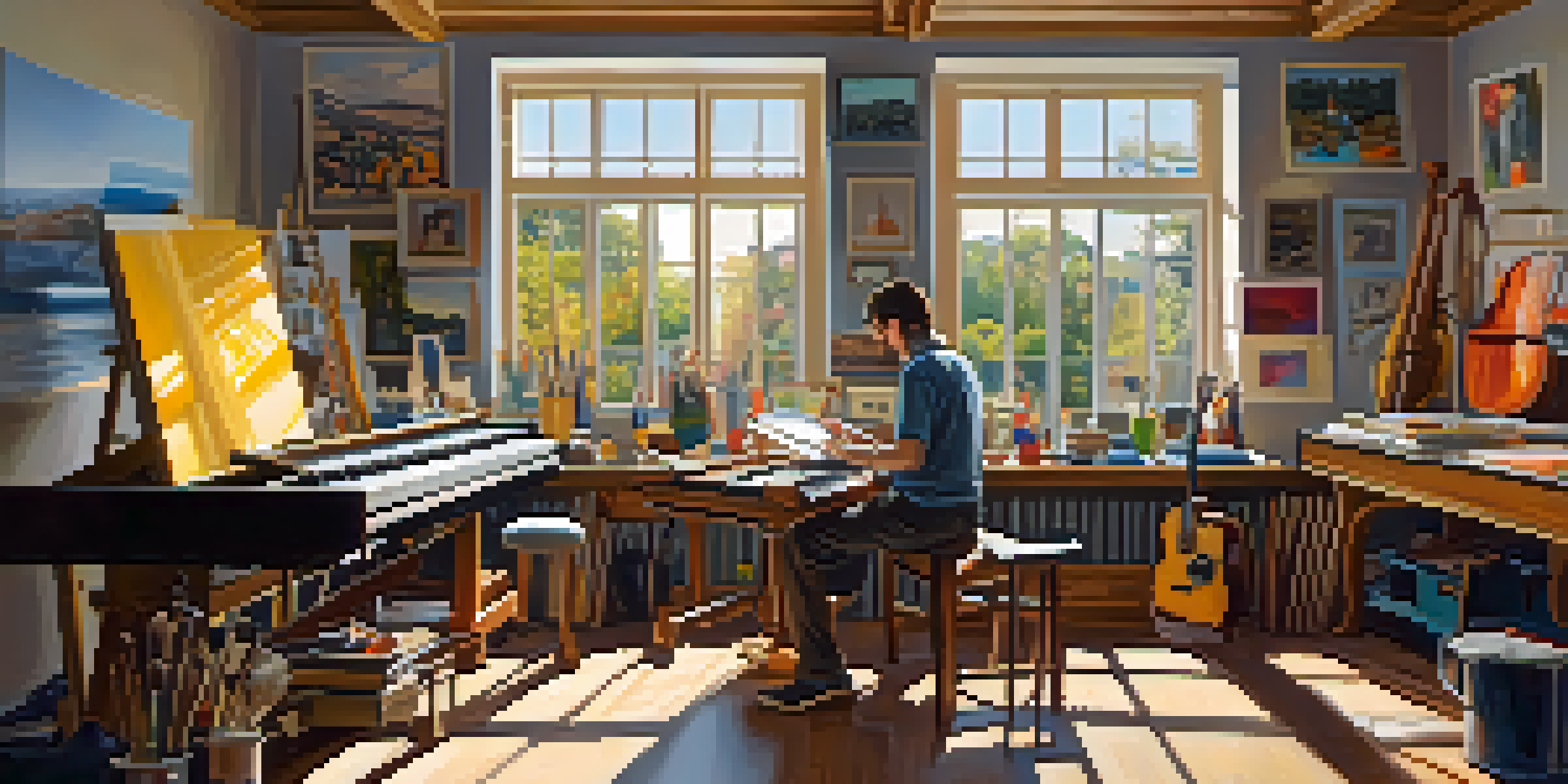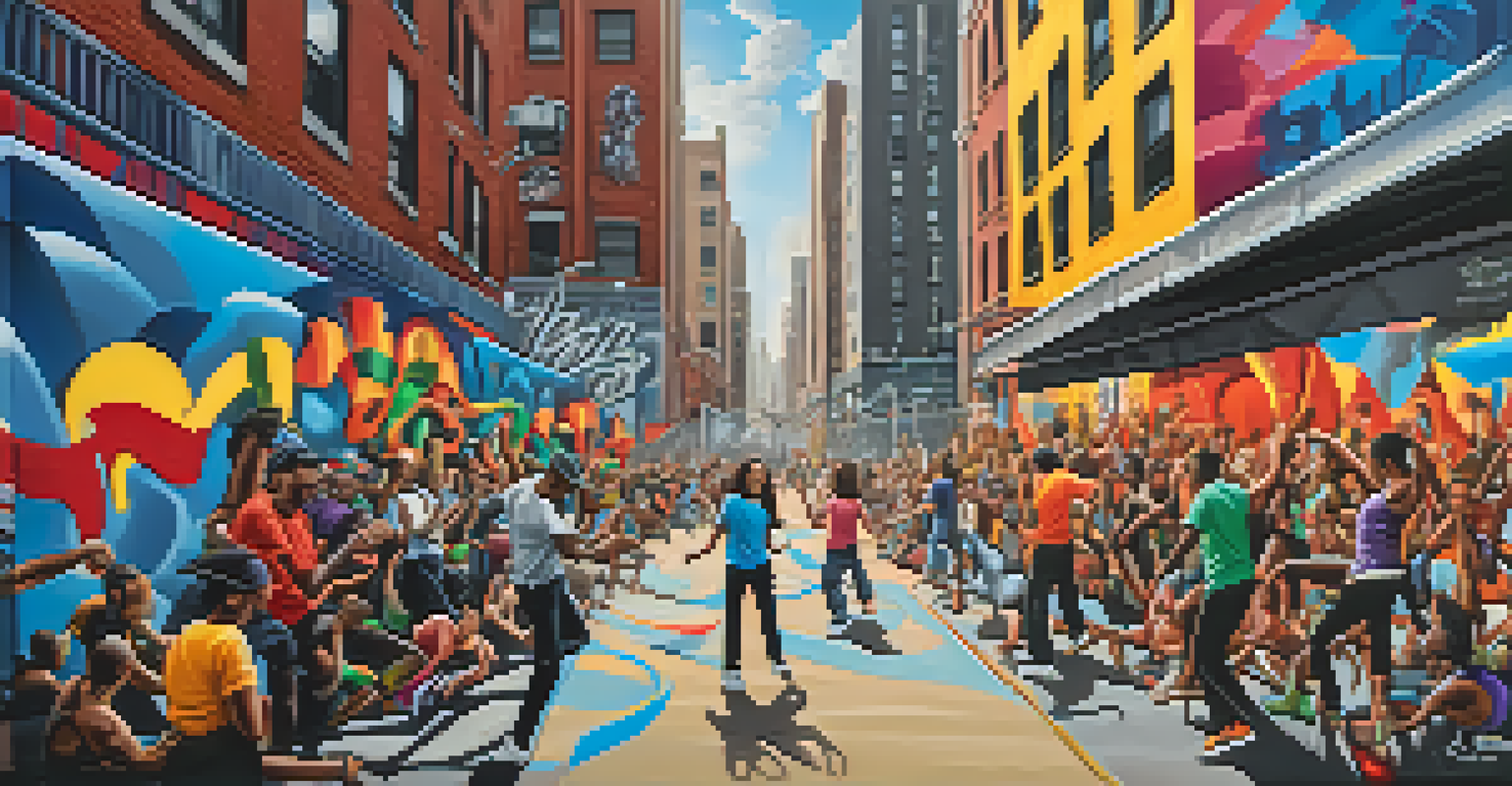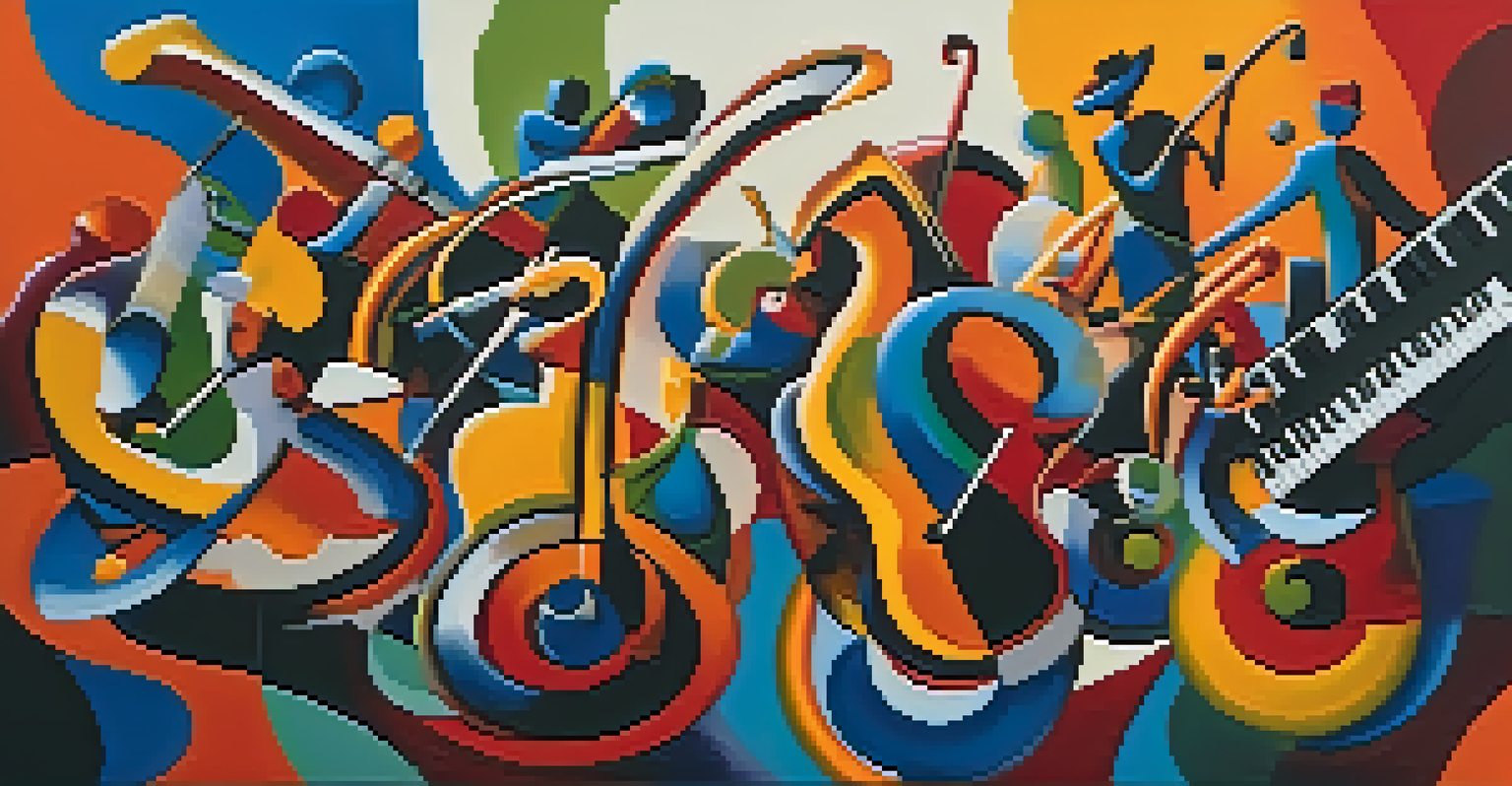The History of Music's Influence on Visual Art Movements

The Interplay Between Music and Art: A Historical Overview
Throughout history, music and visual art have influenced each other in profound ways. From the rhythmic beats echoing in the background of a painter's studio to the emotional resonance of a symphony guiding a sculptor's hand, these art forms have often shared a creative space. Artists have drawn inspiration from musical movements, reflecting the cultural and emotional landscapes of their times.
Music is the shorthand of emotion.
For instance, during the Renaissance, the harmony of music was mirrored in the balanced compositions of painters like Raphael. Similarly, the Baroque period saw an explosion of emotion in both music and art, with composers like Bach and artists like Caravaggio pushing boundaries. This synergy highlights the interconnectedness of these disciplines, suggesting that one cannot be fully understood without the other.
As we delve deeper into this relationship, we can see how specific music genres have sparked visual art movements, creating a dialogue that spans centuries. This exploration reveals the rich tapestry woven by these artistic forms, illustrating how rhythm, melody, and color can coalesce to create something truly remarkable.
The Influence of Classical Music on Romanticism in Art
The Romantic period in the 19th century marked a significant shift in both music and visual arts, characterized by an emphasis on emotion and individualism. Composers like Chopin and Liszt crafted pieces that evoked deep feelings, while painters like Turner and Delacroix captured the essence of those emotions on canvas. This mutual influence created a vibrant exchange, where music served as both inspiration and backdrop for artists.

For example, the dramatic landscapes painted by Turner often mirrored the passionate crescendos found in Romantic symphonies. Similarly, the evocative use of color and light in art reflected the emotional intensity found in the melodies of the time. This connection illustrates how the expressive power of music can enhance visual storytelling, allowing viewers to experience the same emotions conveyed through sound.
Music Inspires Visual Art Movements
Throughout history, various music genres have sparked significant visual art movements, illustrating a deep interconnectedness between these creative forms.
Ultimately, the Romantic movement solidified the bond between music and visual art, paving the way for future artistic collaborations. As artists sought to evoke emotion and explore the human experience, they found a willing partner in music, which provided the rhythm and depth necessary to convey their visions.
Jazz and the Birth of Modern Art Movements
The early 20th century saw the emergence of jazz, a genre that would not only revolutionize music but also influence visual art movements like Abstract Expressionism and Surrealism. The improvisational nature of jazz resonated with artists seeking to break free from traditional forms and explore new ways of expression. This artistic liberation allowed for a vibrant cross-pollination between these two fields.
Art is the most beautiful of all lies.
Artists like Jackson Pollock and Wassily Kandinsky drew inspiration from jazz's spontaneity, creating works that captured the rhythm and energy of jazz music. Pollock's drip paintings, for example, can be seen as a visual representation of the jazz improvisation process, where each stroke is akin to a note in a musical score. This connection between sound and sight illustrates how the freedom of jazz allowed artists to explore their inner emotions and creative impulses.
Moreover, the cultural significance of jazz, rooted in African American history, prompted artists to address themes of identity and social change. This synergy not only enriched the art world but also provided a platform for discussing broader societal issues, showcasing how music can serve as a catalyst for visual exploration and expression.
Rock 'n' Roll and the Rise of Pop Art
The vibrant energy of rock 'n' roll in the mid-20th century sparked the rise of Pop Art, a movement that celebrated popular culture and consumerism. Artists like Andy Warhol and Roy Lichtenstein drew inspiration from the icons of rock music, blending visual art with the bold aesthetics of album covers and advertisements. This fusion created a new language that resonated with a generation captivated by music and media.
Warhol's famous Campbell's Soup Cans and portraits of rock legends like Elvis Presley highlight the intersection of music and art, challenging the distinction between high and low culture. By elevating everyday objects and celebrities to the status of art, these artists reflected the changing societal values of their time, driven by the cultural impact of rock music. This movement not only transformed the art world but also reshaped popular culture as a whole.
Romanticism Strengthens Artistic Bonds
The Romantic period showcased a vibrant exchange where music and visual art mutually inspired emotional expression and individualism.
As rock music continued to evolve, so too did the visual language of Pop Art, creating a dynamic relationship that captured the zeitgeist of the era. The interplay between these two forms of expression showcases how music can inspire visual artists to comment on society, culture, and identity in innovative ways.
The Role of Music in the Development of Abstract Art
Abstract art emerged as a powerful movement in the 20th century, paralleling the evolution of music styles such as atonality and avant-garde compositions. Artists like Piet Mondrian and Kazimir Malevich sought to express emotions and ideas through non-representational forms, much like composers like Arnold Schoenberg were breaking away from traditional tonal structures. This movement underscored the idea that art and music could exist independently of the natural world.
The rhythmic quality inherent in both abstract art and avant-garde music fosters a unique dialogue, where each medium complements the other. For example, Mondrian's use of geometric shapes and primary colors can be likened to the dissonant harmonies found in Schoenberg's compositions, both aiming to evoke a sense of order and chaos simultaneously. This connection illustrates how artists were influenced by the innovations in music, leading to a reimagining of visual language.
As abstract art continued to evolve, its relationship with music deepened, creating a space for artists to explore new dimensions of creativity. This collaboration between sound and sight has had a lasting impact on contemporary art, showing how the realms of music and visual art can intertwine to inspire new artistic expressions.
The Impact of Hip-Hop Culture on Street Art
The rise of hip-hop culture in the late 20th century has had a profound influence on street art, creating a vibrant visual language that reflects the rhythms and messages of hip-hop music. Graffiti artists often use their work to express social commentary, much like hip-hop lyricists do through their verses. This synergy between music and visual art has transformed urban landscapes into dynamic canvases for cultural expression.
Street artists like Banksy and Jean-Michel Basquiat have drawn inspiration from the raw energy and storytelling found in hip-hop, incorporating elements of music culture into their artwork. Basquiat, for instance, often infused his pieces with references to music, creating a dialogue that bridged the gap between visual and auditory art forms. This connection highlights the power of hip-hop as a vehicle for social change and artistic expression.
Hip-Hop Transforms Street Art
The rise of hip-hop culture has profoundly influenced street art, creating dynamic expressions that reflect the themes and rhythms found in hip-hop music.
Moreover, the collaborative spirit of hip-hop, which often includes DJs, MCs, and visual artists, has fostered a sense of community and shared purpose. This interconnectedness allows for a rich exchange of ideas and styles, demonstrating how music can inspire and elevate visual art, ultimately shaping the cultural landscape of our cities.
Conclusion: The Everlasting Bond of Music and Visual Art
The exploration of music's influence on visual art movements reveals a rich tapestry of creativity and collaboration. From the emotional depths of Romanticism to the bold statements of Pop Art, the dialogue between these two art forms has continually evolved, shaping the way we understand and appreciate both. This relationship illustrates that art is not confined to a single medium but thrives in the interplay of multiple expressions.
As we look to the future, it's clear that music will continue to inspire visual artists, just as visual art will influence musicians. The ongoing exchange between these forms is a testament to the power of creativity, reminding us that the arts are interconnected and can amplify each other's messages. This synergy invites us to explore new horizons, pushing the boundaries of what art can be.

In a world where creativity knows no limits, the bond between music and visual art will undoubtedly endure, enriching our cultural landscape and inviting future generations to explore the magic that arises when these two powerful forms of expression come together.